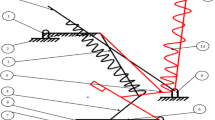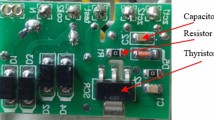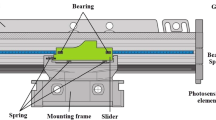Abstract
Traditional method evaluates operating reliability by counting life-test results of a small number of samples, which ignores variability between individuals and cannot accurately reflect the true state. This paper proposes a model for predicting operational reliability of mechanism in a batch of micro-switches based on manufacturing parameters, in view of complex structure and diverse manufacturing parameters. A multi-body kinetic model based on manufacturing parameters and principle of action considering contact fatigue and wear was established, and the operating characteristics in the degradation process with sliding wear of joints were obtained. Finally, the linkage with revolute clearance in miniature circuit breaker (MCB) was used as numerical example application to perform investigation. Prediction results are consistent with batch experiments, which verifies accuracy of model. In addition, the optimal combination of clearances was obtained by using genetic algorithm based on predicted model, which increases locking reliability to 99.3% after 10000 operation cycles.
Similar content being viewed by others
References
C. M. Huang, J. A. Romero and M. Osterman, Life cycle trends of electronic materials, processes and components, Microelectronics Reliability, 99(8) (2019) 262–276.
X. R. Ye, H. Chen and C. Chen, Life-cycle dynamic robust design optimization for batch production of permanent magnet actuator, IEEE Transactions on Industrial Electronics, 68(10) (2020) 9885–9896.
T. Augustin, M. Becerra and H. P. Nee, Enhanced active resonant DC circuit breakers based on discharge closing switches, IEEE Transactions on Power Delivery, 36(6) (2021) 1735–1743.
Q. Wang, X. W. Li and D. G. Chen, Analysis of the interruption process of selective miniature circuit breaker with permanent magnet release, IEEE Transactions on Components Packaging and Manufacturing Technology, 4(7) (2014) 1177–1183.
Y. Yao and N. Wang, Fault diagnosis model of adaptive miniature circuit breaker based on fractal theory and probabilistic neural network, Mechanical Systems and Signal Processing, 142(8) (2020) 106772.
Y. Zhang and A. C. Wang, Remaining useful life prediction of rolling bearings using electrostatic monitoring based on two-stage information fusion stochastic filtering, Mathematical Problems in Engineering, 2020(5) (2020) 1–12.
I. Zamudio-Ramirez, R. A. Osornio-Rios and J. A. Antonino-Daviu, Gradual wear diagnosis of outer-race rolling bearing faults through artificial intelligence methods and stray flux signals, Electronics, 10(6) (2021) 1486.
Q. Wan, G. Liu and Y. Zhou, Numerical and experimental investigation on electromechanical aileron actuation system with joint clearance, Journal of Mechanical Science and Technology, 33(2) (2019) 525–535.
Y. Chen, J. Feng and Q. He, A methodology for dynamic behavior analysis of the slider-crank mechanism considering clearance joint, International J. of Nonlinear Sciences and Numerical Simulation, 22(6) (2021) 373–390.
S. Mukras, N. H. Kim and N. A. Mauntler, Analysis of planar multi-body systems with revolute joint wear, Wear, 22(2) (2020) 643–652.
Z. F. Bai, Y. Zhao and X. G. Wang, Wear analysis of revolute joints with clearance in multi-body systems, Science China-Physics, Mechanics and Astronomy, 56(8) (2013) 1581–1590.
Z. F. Bai, H. B. Zhang and Y. Sun, Wear prediction for dry revolute joint with clearance in multi-body system by integrating dynamics model and wear model, Latin American J. of Solids and Structures, 11(6) (2014) 2624–2647.
S. Jiang, X. L. Chen and Y. Deng, Dynamic response analysis of planar multilink mechanism considering wear in clearances, Shock and Vibration, 2019(8) (2019) 1–18.
X. C. Zhuang, T. X. Yu and J. Y. Liu, Kinematic reliability evaluation of high-precision planar mechanisms experiencing non-uniform wear in revolute joints, Mechanical Systems and Signal Processing, 169(4) (2022) 108748.
C. W. Fei, H. Li and H. T. Liu, Enhanced network learning model with intelligent operator for the motion reliability evaluation of flexible mechanism, Aerospace Science and Technology, 107(12) (2020) 106342.
C. W. Fei, H. T. Liu and R. P. Liem, Hierarchical model updating strategy of complex assembled structures with uncorrelated dynamic modes, Chinese J. of Aeronautics, 35(3) (2022) 281–296.
C. W. Fei, H. T. Liu and Z. Z. Zhu, Whole-process design and experimental validation of landing gear lower drag stay with global/local linked driven optimization strategy, Chinese J. of Aeronautics, 34(2) (2021) 318–328.
S. Q. Ling, L. Xu and D. H. Li, Fretting wear reliability assessment methodology of gold-plated electrical connectors considering manufacture parameters distribution, Microelectronics Reliability, 114(9) (2020) 1–5.
H. C. Meng and K. C. Ludema, Wear models and predictive equations: their form and content, Wear, 181–183(5) (1995) 443–457.
F. Yin, H. J. Mao and L. Hua, Back propagation neural network based calculation model for predicting wear of fine-blanking die during its whole lifetime, Computational Materials Science, 59(6) (2012) 140–151.
G. N. Chu, S. Yang and J. X. Wang, Mechanics condition of thin-walled tubular component with rib hydroforming, Transactions of Nonferrous Metals Society of China, 22(12) (2012) s280–s286.
Y. X. Sun, C. F. Song and Z. L. Liu, Tribological and conductive behavior of Cu/Cu rolling current-carrying pairs in a water environment, Tribology International, 143(5) (2020) 1–8.
Y. K. Liu, L. Guo and H. L. Gao, Machine vision based condition monitoring and fault diagnosis of machine tools using information from machined surface texture: a review, Mechanical Systems and Signal Processing, 164(2) (2022) 1271–1275.
S. Mirjalili and A. Lewis, The whale optimization algorithm, Advances in Engineering Software, 95(5) (2016) 51–67.
B. J. Chen, X. F. Chen and B. Li, Reliability estimation for cutting tools based on logistic regression model using vibration signals, Mechanical Systems and Signal Processing, 25(11) (2011) 2526–2537.
B. R. Ding, X. H. Qu and Y. L. Chen, Application and research of mechanical design optimization based on genetic algorithm kinematics simulation technology, J. of Intelligent and Fuzzy Systems, 34(4) (2017) 871–878.
Author information
Authors and Affiliations
Corresponding author
Additional information
Donghui Li the received the B.S. from Department of Thermal Energy and Power Engineering, Jilin Institute of Chemical Technology, Jilin, China, in 2015. His research interests include low voltage electrical apparatus design.
Xue Zhou received the Ph.D. from the Department of Electrical Engineering, Harbin Institute of Technology, Harbin, China, in 2011. He is currently a Lecturer in Electrical Engineering, Harbin Institute of Technology. His current research interests include arc simulations and the experiment techniques of relays and contactors.
Sanqiang Ling received the B.S. in Electrical Engineering and Automation from the Harbin Institute of Technology, Harbin, China, in 2017, where he is currently pursuing the Ph.D. in Electrical Engineering. His current research interests include electrical connector reliability.
Yue Jin received the B.S. from the Department of Mechanical Engineering, Jiangnan University, Wuxi, China, in 2018. Her research interests include low voltage electrical apparatus design.
Guofu Zhai received his Ph.D. from Harbin Institute of Technology, Harbin, China, in 1998. He is currently a Professor of the Department of Electrical Engineering at Harbin Institute of Technology. His research interests include reliability robust design optimization and testing techniques of electronic devices and systems.
Rights and permissions
About this article
Cite this article
Li, D., Zhou, X., Ling, S. et al. Prediction of operating reliability of multi-body mechanism in micro-switches considering parameter distribution and wear of parts. J Mech Sci Technol 36, 3399–3407 (2022). https://doi.org/10.1007/s12206-022-0618-4
Received:
Revised:
Accepted:
Published:
Issue Date:
DOI: https://doi.org/10.1007/s12206-022-0618-4




